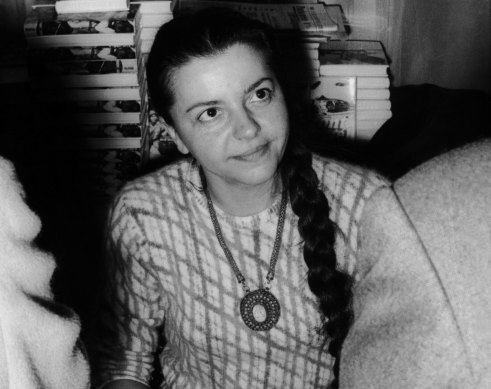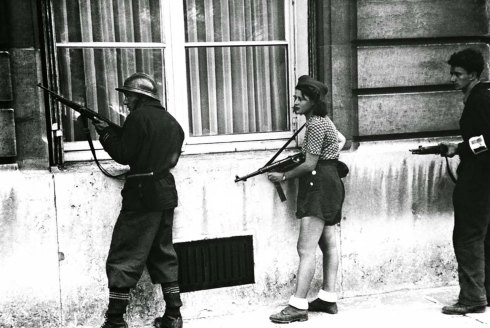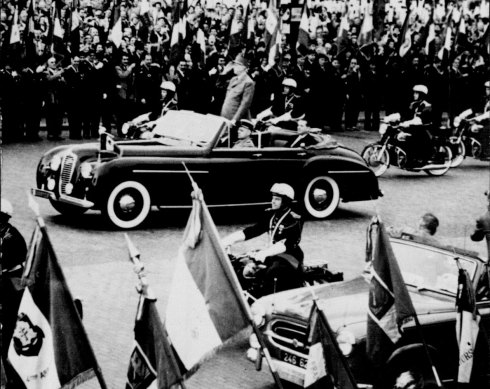One of the last women who joined the French Resistance during WWII
In early 1941 in Nazi-occupied France, a German officer stopped a 17-year-old girl and her ailing grandfather. She explained that they were taking the train to see family in their home village near Amiens, between Paris and the Belgian border.
The German kicked the girl. She fell with her face landing in a gutter.
“I was humiliated, my fear turned into anger,” recalled Madeleine Riffaud. “I remember saying to myself, ‘I don’t know who they are or where they are, but I’ll find the people who are fighting this and I’ll join them’.”

Madeleine Riffaud at a book signing in Paris, 1968.Credit: Gamma-Keystone via Getty Images
Riffaud’s war began that day. She later made her way to Paris at the front lines of the French Resistance – the first chapter in a peripatetic life that included years as a war correspondent in Algeria and South-East Asia, renown as a writer and caretaker of memories of Paris in wartime and liberation. Her first collection of postwar poems included a portrait of her drawn by Pablo Picasso.
As part of the Resistance, she collected guns, organised sabotage missions, recruited fighters and once shot and killed a German officer on a Sunday afternoon on a bridge over the Seine as crowds watched. “He fell like a sack of wheat,” said Riffaud, who died on November 6 at her home in Paris at the age of 100.
She was captured moments after the shooting and tortured by the Nazi secret police Gestapo for weeks with electric shocks and beatings. “I don’t know how I didn’t talk,” she told The Guardian in 2004, “but I didn’t.”
Riffaud was released in a prisoner exchange in mid-August 1944, just as the Resistance was engaged in a major mobilisation ahead of advancing Allied troops. She quickly rejoined her comrades.
The uprising left hundreds of Resistance fighters and others dead but drove Nazi forces back to garrisons around the city. By the early hours of August 25, 1944, German defences were crumbling. The Resistance staged commando-style attacks, and Allied forces took prisoners and overran German lines.
“Everyone who came on to the street got a gun. Kids dug up the roads, people threw down beds, furniture, anything to build the barricades,” Riffaud told The Guardian, recalling the mass outpouring in the final battles for the city.
“It was – almost – a party,” she added.
In the past decade, Riffaud was visited by historians, journalists and dignitaries as one of the last links to the French Resistance and the many women who took part with roles such as couriers, spies and armed fighters. Robert Gildea, a University of Oxford history professor whose 2015 book Fighters in the Shadows explores the array of people involved in the Resistance, described women as the “hinges of the resistance”, juggling various duties and often able to pass more easily through checkpoints.
Alongside Riffaud in combat were women including guerilla commander Alice Arteil External, code-named Sylva, and bomb specialist Simone Segouin, who was shown in Life magazine holding a captured German MP-40 submachine gun – a photo that came to define the courage of women in the Resistance. Segouin’s nom de guerre was Nicole.

Simone Segouin pictured taking cover during the liberation of Paris in August 19, 1944.Credit:
Riffaud was known as Rainer, reflecting her admiration for Rainer Maria Rilke, a poet born to a German-speaking family in Prague and who died in 1926.
Months after she was kicked by the German officer during her train journey, she was diagnosed with early symptoms of tuberculosis and sent to a sanatorium near Grenoble in the French Alps. The facility was also a clandestine hub for the Resistance, she wrote in her 1994 autobiography, On l’appelait Rainer.
After her health improved, Riffaud was taken into the Resistance ranks and sent to Paris in late 1941. Her cover story was that she was studying to be a midwife. One of her tasks was scrounging weapons.
“I got quite good at it,” Riffaud remembered. “I’d walk up to a policeman and sweet talk him, then show him our requisition bill which said the Resistance needed his revolver. I would say he could do the patriotic thing.”
If the policeman hesitated, she would gesture to her Resistance cohorts – often burly men – who stood off to the side. “We got a lot of pistols that way,” she said.
In early July 1944, less than a month after the D-Day landings of Allied troops in Normandy, the Resistance in Paris began efforts to stir a mass rebellion on the streets. The orders were for Resistance fighters to kill a German soldier in daylight in a public place.

General Charles de Gaulle salutes as he drives past the standards of the Old Comrades Associations of French exservicemen and women in 1958 to commemorate on behalf of France the founding of the French Resistance Movement.Credit: Sport & General Press Agency Limited
Riffaud was riding a bike on July 22 when she spotted a German officer who had paused to gaze at the Seine from a footbridge across from the Tuileries Garden. She stopped – as if to take in the view as well – and shot the German twice in the left temple.
Crowds in the garden witnessed the execution. “It was right,” she added. “I felt very calm, very pure.”
By chance, a French police unit with the collaborationist Vichy regime was nearby and rammed her bike as she tried to flee. She tried to grab her gun to shoot herself rather than be captured, she recounted. But she was handcuffed too quickly and handed over to the Gestapo.
In the days after her release, the Resistance was on a full offensive. She took part in an operation that stranded a German supply train in a tunnel, leading to the capture of 80 Wehrmacht soldiers. It was her 20th birthday. She celebrated with ham, dried sausages and jam found on the train.
As LeClerc’s troops entered Paris, she was among Resistance fighters storming the barracks of the German SS forces at the Place de la République.
“You cannot understand how wonderful it was to fight finally as free men and women, to battle in the daylight, under our own names, with our real identities, with everyone out there, all of Paris, to support us, happy, joyful and united,” she said in the Guardian interview. “There was never a time like it.”
More than six decades later, she still revelled in the glory of liberation, but she struggled with the memories of what was required.
“Killing someone is a terrible thing to do,” she told the British Times newspaper in 2016. “It is never good to kill anyone, even an enemy.”
Marie-Madeleine Riffaud was born in the French village of Arvillers, southeast of Amiens, on August 23, 1924. Her parents were teachers and became staunch pacifists after enduring the nearby battles during World War I.
She later became a journalist and covered parts of Algeria’s 1954-62 war for independence from France for the French newspaper L’Humanité. In the Algerian port of Oran, she and a colleague were involved in a serious road accident. She lost a finger on her right hand and was left blinded in one eye.
A meeting in Paris with Ho Chi Minh, leader of the nationalist forces in North Vietnam battling French colonial rule, sparked her interest in South-East Asia. She covered the Vietnam War with the North Vietnamese-backed guerillas, known as Viet Cong, battling the US military and its South Vietnamese allies.
She returned to France and worked as a nursing assistant in a Paris hospital, leading to a best-selling book, Les Linges de la nuit (1974), or “Night Linens”, describing failures of the French medical system. An anthology of her poetry, Cheval rouge (“Red Horse”), was published in 1973.
She received the French National Order of Merit in 2013.
In 1945, she married Pierre Daix, a writer and survivor of the Mauthausen concentration camp. They had a daughter before the marriage ended in separation. Riffaud had a five-decade relationship with the North Vietnamese poet and composer and Ho Chi Minh political ally Nguyen Dinh Thi, but they did not marry. He died in 2003.
“The essential [thing] was not to give in,” said Riffaud when asked about her Resistance years. “When you resisted, you were already a victor. You had already won.”
The Washington Post
Get the best of Good Weekend delivered to your inbox every Saturday morning. Sign up for our newsletter.